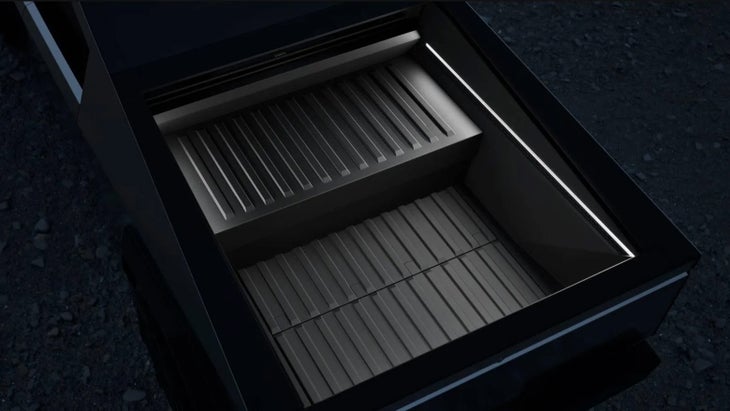No products in the cart.
Outdoor Adventure
Tesla’s Cybertruck Finally Reaches Production. You May Still Wait Years.
Four years after it was first unveiled, the Tesla Cybertruck has reached its first dozen-or-so customers. Rather than focusing on Tesla CEO Elon Musk’s recent problems with antisemitic hate speech, all the production and design issues that led to years-long delays, or even all the broken promises about price and performance, we’ll focus instead on nothing but the raw specs revealed at this week’s launch event: how do they compare to all the other electric pickup trucks already on the road—and with trucks that will be by the time the cheapest Cybertruck will allegedly reach production in 2025.
Throughout this piece you’re going to note words like “estimated,” or “should.” It’s important to note a few things that make writing a story about Tesla a little different than writing a story about other car companies. Not only does Musk have a history of exaggerating when he talks about Tesla products, but the company employs no public relations people, does not produce press materials, and many of the numbers being released this week are couched in the company’s own disclaimers. Without the ability to call a Tesla representative and check facts, media outlets are left reporting only on what scarce information Tesla makes public.
How Much Will The Tesla Cybertruck Cost?
The Cybertruck will eventually be available in three trim levels. Tesla says the most basic rear-wheel drive, single-motor version will cost $60,990 and have an estimated unladen range of 250 miles, while accelerating from zero to 60 miles per hour in and estimated 6.5 seconds.
Tesla quotes a maximum payload for the Cybertruck of 2,500 pounds, which is presumably for this most basic version, with the smallest, lightest battery pack. There is no word what that number is for other trim levels.
A $70,990 two-motor all-wheel drive version will come with a larger battery (there’s no details on actual kilowatt-hours) that extends unladen range to 340 miles and drops 0-60 miles-per-hour time to 4.1 seconds. Again, those numbers are estimates.
Then there’s the top-spec Cyberbeast, which will cost $99,900, feature a 320-mile unladen range, and do 0-60 in 2.6 seconds. Cyberbeast’s acceleration figure deserves its own caveat though, because it’s been calculated using a one-foot rollout, a method which knocks a third of a second or so off the stopwatch. It appears as if Cyberbeast will come equipped with 35-inch tires (which likely explains its range reduction). It is not clear what size tire lesser trims will come with. According to an analysis on The Autopian, it is unlikely that it will be possible to fit the Cybertruck with larger tires than what it ships with.
How Does The Cybertruck Compare To Other EVs?
A basic Ford F-150 Lightning, which you can find sitting on dealer lots right now, available for immediate purchase, starts at $49,995. That price includes two motors and AWD, along with a 240-mile unladen range and a 4.2-second 0-60 time. Payload capacity is 2,235 pounds.
An extended range F-150 Lightning starts at $69,995, has a 320-mile unladen range, and does 0-60 in 3.8 seconds. The larger, heavier battery pack drops payload capacity to 1,657 pounds.
The $87,000 Rivian R1T Quad Motor has a 328-mile unladen range, can carry 1,764 pounds, and does the 0-60 MPH sprint in 3.0 seconds, as verified by Car and Driver. The Cyberbeast accelerates quicker, but only by the slimmest of margins.
What about towing? All the current EV pickups feature about the same 11,000 pound max trailer capacity as the Cybertruck, but none of them has anything like the range necessary to function as a practical choice in that role, even for short trips, and none can use most charging stations while a trailer is attached. That’s a problem the upcoming 2025 Ram 1500 Ramcharger solves, albeit with the aid of an internal combustion range extender. That vehicle will feature a 2,625 pound payload and 14,000 pound tow capacity.
When Will I Get My Cybertruck?
During Thursday’s unveiling, Musk made a big show of a handful of customers taking deliveries of their Cybertrucks on stage. He’s previously stated that almost one million people have placed refundable $100 deposits for the vehicle. When will they be given the option to complete a purchase? That remains unclear.
On Tesla’s website, availability for Cyberbeast and standard AWD model are listed for 2024. The basic RWD version claims it will be “available in 2025.” It is murky when series production is scheduled to begin, what volumes Tesla is targeting, what the order process will be for customers, or what priority will be given to existing refundable deposit holders. Tesla is now taking another $250 deposit on its website.

How Big Is The Cybertruck?
Motor Authority reports that the Cybertruck is 95 inches wide, 223.7 inches long, and 70.5 inches tall. It’s not yet certain if that height is measured with 35 inches tires. The AWD model is said to weigh 6,603 pounds.
Those numbers put it at about the same size size as a crew cab Ford F-150 (albeit a few inches lower), but it weighs more than some trim levels of the Ford Super Duty.
Tesla says the Cybertruck’s bed is six feet long and four-feet wide. That’s the same length as long bed Toyota Tacoma, but about a foot narrower. During his presentation, Musk claimed the Cybertruck can haul 4×8-foot “construction materials,” with the tailgate lowered. Pictures show a tonneau cover unrolling from the cab to secure the bed.

There are two important caveats on bed dimensions. Musk claims the Cybertruck will be available with a “range extender” which appears to be an auxiliary battery pack. While there are no details on that device’s weight, capacity, or if customers will be able to move it in and out of the truck themselves, there is a picture showing that it will take up approximately one-third of the bed space.
The Cybertruck does not appear to come equipped with a spare tire. Instead, owners who opt to purchase one will need to carry that in the bed. A 35-inch spare will also take up about half the available bed space. Equipped with both the “range extender” and a spare tire, how much of the bed will remain available for cargo is rather opaque.

How Good Will The Cybertruck Be Off-Road?
During Thursday’s presentation, Musk claimed that the Cybertruck will feature locking differentials.
On an internal combustion vehicle, locking the speeds of the front and rear axles together mechanically creates an arrangement commonly known as four-wheel drive. But that leaves the wheel on each axle with the least traction free to spin as fast as its counterpart on the opposite axle. Locking the axle differentials then matches wheel speeds across those axles. Putting a vehicle in four-wheel drive and locking both axle differentials maximizes traction off-road.
It is not evident if the Cybertruck’s locking differentials will be mechanical, or simply a software function. As with all other current EVs, there is no mechanical connection between the axles, so matching wheel speeds between them will be handled by programming.
Regardless, it appears as though Cybertruck, at least in its Cyberbeast trim, will at least be able to match the traction provided by off-road-oriented competitors like the GMC Hummer EV and Rivian R1T.
Like the Hummer EV, Cyberbeast will feature 35-inch tires, and rear-wheel steering. The former will help them climb over large obstacles, the latter makes these very large trucks much more maneuverable in tight spaces. Tesla says ground clearance on Cyberbeast is 17 inches. Hummer EV features height-adjustable suspension that can create as much as 16 inches of clear air under the truck. These numbers sound impressive in comparison to gas trucks because the EVs use independent suspension in the front and rear. Most gas trucks use a solid rear axle, and that big metal beam running between the rear wheels results in less impressive ground clearance numbers. Ground clearance is not all that important a metric—rather, it’s a vehicle’s approach, departure, and breakover angles that determine its ability to clear or climb large obstacles.
And while there is no word on those angles for any version of the Cybertruck, it is unlikely that they will come close to those achieved by the Hummer EV. Not only is that vehicle seven inches shorter in length, but its front and rear wheels are both pushed to the extreme ends of the platform, significantly enhancing the Hummer EV’s ability to clear obstacles.

How Efficient Will The Cybertruck Be?
Tesla is not releasing battery capacity numbers for any version of the Cybertruck at this time. It does say the drag coefficient is 0.335. That’s significantly behind EV sedans like the Tesla Model S, which has a drag coefficient of 0.208. The heaviest Model S is also fully 2,000 lbs lighter than the AWD Cybertruck. Moving the Cybertruck will take significantly more energy.
While cradle to grave emissions for EVs—even on our country’s relatively dirty energy grid—are half that of an internal combustion equivalent, that equivalent for the Cybertruck is going to be a very large, very heavy, very thirsty vehicle: just like a heavy duty pickup.
Producing a large, heavy, complicated EV, complete with what’s presumably going to be a very large battery pack takes enormous amounts of energy. While we don’t have numbers for the Cybertruck yet, The Drive reports that it takes 50.6 metric tons of carbon just to put a Hummer EV in your driveway.
There’s also the question of what type of vehicle buyers will be replacing with the Cybertruck. Where manufacturers like Ford are putting significant efforts into enabling governments and corporations to replace their vast fleets of heavily polluting internal combustion work trucks with practical EV pickups like the F-150 Lightning, according to a report in The New York Times, Tesla has no such plans, and instead will sell the Cybertruck to, “well-to-do technology savants and collectors.” In other words, it’s just another expensive luxury vehicle, at least for now.
Unless Tesla can reach extremely large production volumes with this thing, moving hundreds of thousands of Americans out of large internal combustion pickups in the process, it’s unlikely the Cybertruck is going to save the planet.
Should You Buy A Cybertruck?
Beyond the polarizing design (I think it looks great), it’s difficult to find anything that makes the Cybertruck unique. Neither its price nor range are fully competitive in today’s EV pickup market.
And that space is going to continue to develop in the years Tesla says it will take to roll out all versions of the vehicle. By 2025, Stellantis says it plans to sell an electric truck with 500 miles of all-electric range, in addition to one equipped with a gasoline-powered range extender, complete with unimpaired beds and spare tires. And those are just products we know about now.
What about performance? The most expensive trim level of the Cybertruck—Cyberbeast—is only a fraction of a second quicker than existing electric pickups. Beyond bragging rights, this won’t deliver any tangible benefits to owners.
Will this thing be the ticket to zero emissions overlanding? It’ll be about as good as a normal pickup truck like a basic Ford F-150 FX4 off-road, which is to say not very. And like any other electric vehicle, its range will massively limit utility in that role. Efficiency is typically halved on dirt, and with no easy means of topping off energy away from America’s patchy charging infrastructure, that means it’ll be limited to off-road adventures of 85 miles or less before you need to turn around and head back to one of those chargers.
When Elon Musk originally announced the Cybertruck in 2019, there weren’t yet any electric pickups you could buy. The idea of combining zero tailpipe emissions and EV performance into a practical vehicle you could use to replace a gas pickup for most jobs sounded really futuristic. Today, that idea is no longer novel. And neither is the Cybertruck.
But none of this really matters. Without firm production numbers or dates, and with so many existing reservations, it’s unlikely that you’ll be able to just go out and purchase a Cybertruck any time soon, if ever.
Source link

